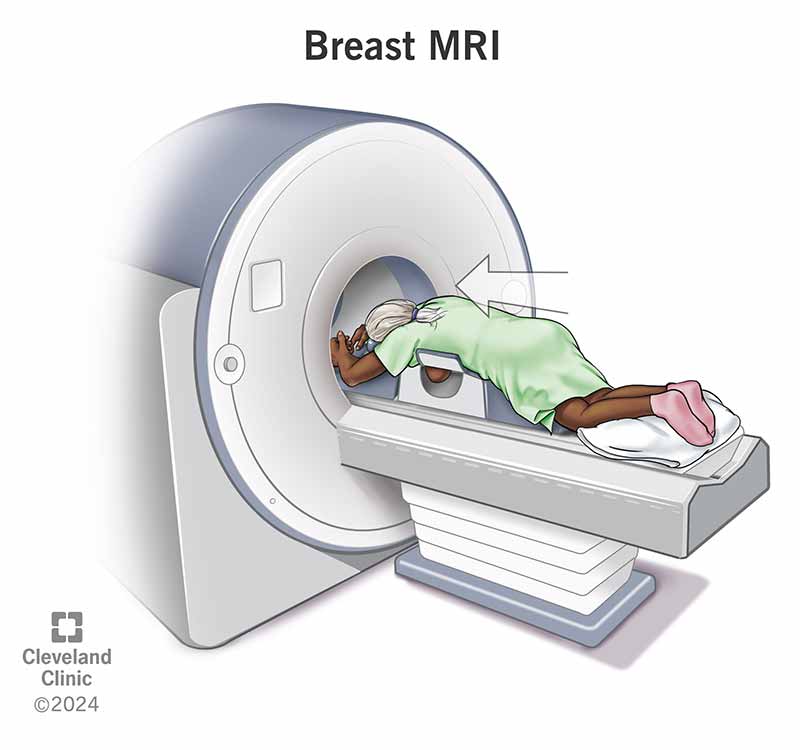A breast MRI is an imaging test that produces very detailed pictures of breast tissue. Healthcare providers mainly use it to evaluate known breast cancer. But they also use it in addition to mammography and ultrasound to screen for and diagnose breast cancer and other breast abnormalities.
Advertisement
Cleveland Clinic is a non-profit academic medical center. Advertising on our site helps support our mission. We do not endorse non-Cleveland Clinic products or services. Policy
Breast MRI (magnetic resonance imaging) is a type of imaging test that uses a large magnet, radio waves and a computer to produce detailed images of breast tissue. Unlike mammograms, a breast MRI doesn’t use X-rays. Your healthcare provider may use a breast MRI along with a mammogram to screen for breast cancer. They may also use it to biopsy breast tissue to see if cancer is present or how far cancer extends into your breast tissue.
Advertisement
Cleveland Clinic is a non-profit academic medical center. Advertising on our site helps support our mission. We do not endorse non-Cleveland Clinic products or services. Policy
Your healthcare provider may recommend a breast MRI for several reasons, including:
Depending on the reason for a breast MRI, the test may require an injection of contrast dye (called gadolinium). For many breast MRIs, a technologist or nurse will place an IV in your arm so they can inject contrast dye during the test. This helps a radiologist see normal and abnormal structures in your breast more clearly. This dye is different from the one used during CT scans (computed tomography scans).
Providers often recommend this test to provide more detail after diagnosing breast cancer. It can also:
Advertisement
Breast MRIs may also help your healthcare provider evaluate lumpectomy sites in the years following breast cancer treatment. This is because scarring and recurrent breast cancer can sometimes look similar on mammography and ultrasound.

Before your breast MRI, it’s important to tell your radiologist or radiology technologist if you:
If you have metal-containing objects or implanted medical devices in your body, your healthcare team needs to know about them before your exam. Please tell your provider and MRI technologist if you have any of the following:
You won’t be able to wear the following devices during your MRI:
Talk to the provider you see for these devices to find out what they recommend you do for the MRI.
During a breast MRI, you can expect the following:
Advertisement
You can resume your usual activities after a breast MRI. But if your exam was an MRI breast biopsy, follow the at-home instructions your provider gives you. If you took a sedative for your exam, you’ll need someone else to drive you home.
Although many facilities plan for 40 to 60 minutes for a breast MRI, the scan itself lasts about 20 minutes. The extra time is for screening questionnaires, IV placement and proper positioning for the exam.
There’s very little risk to getting a breast MRI if you and your technologist follow the safety guidelines. The possible risks are:
Depending on whether you got a breast MRI for screening purposes, diagnostic purposes or to evaluate known cancer, your MRI report may look different. In any case, the healthcare provider who ordered the breast MRI will discuss your results with you.
Advertisement
All radiologists use the same standardized system to describe screening and diagnostic breast imaging results. This system is called the Breast Imaging Reporting and Data System (BI-RADS). It categorizes results on a scale of 0 through 6.

The results of your MRI will be available in your electronic medical records account (if you have one) and should be available to the healthcare provider who ordered the test within one to two business days. Your provider will discuss the results with you.
Healthcare providers use mammograms and breast MRIs to help detect breast cancer and other breast abnormalities.
Mammograms are usually the first option for screening and diagnosis of breast cancer, particularly as mammograms are the only imaging test able to reliably identify microcalcifications — an early sign of some breast cancers.
There are also differences in how the two imaging tests work.
| Mammogram | Breast MRI |
|---|---|
| Uses X-rays. | Doesn’t use X-rays. |
| Compresses (squeezes) your breasts. | Doesn’t compress your breasts. |
| Doesn’t use contrast dye (no IV necessary). | Usually requires contrast dye (an IV is necessary). |
| Takes two to three minutes. | Takes 17 to 20 minutes. |
| Mammogram | |
| Uses X-rays. | |
| Breast MRI | |
| Doesn’t use X-rays. | |
| Compresses (squeezes) your breasts. | |
| Breast MRI | |
| Doesn’t compress your breasts. | |
| Doesn’t use contrast dye (no IV necessary). | |
| Breast MRI | |
| Usually requires contrast dye (an IV is necessary). | |
| Takes two to three minutes. | |
| Breast MRI | |
| Takes 17 to 20 minutes. |
One isn’t better than the other. Rather, they have different purposes. Mammograms are the gold standard for breast cancer screening. MRIs may be helpful in addition to mammograms for people with a high risk of breast cancer or who receive a breast cancer diagnosis. Your healthcare provider can discuss which test they recommend based on your situation.
Advertisement
A breast MRI is a helpful tool for screening, diagnosing and evaluating breast cancer and other irregularities of your breast tissue. It’s normal to feel anxious before an MRI. You may have lots of questions or concerns about what the test results may show and what they mean for your health. Don’t hesitate to raise your concerns with your healthcare provider. They can explain a breast MRI to you and walk you through what happens afterward.
Last reviewed on 10/04/2024.
Learn more about the Health Library and our editorial process.